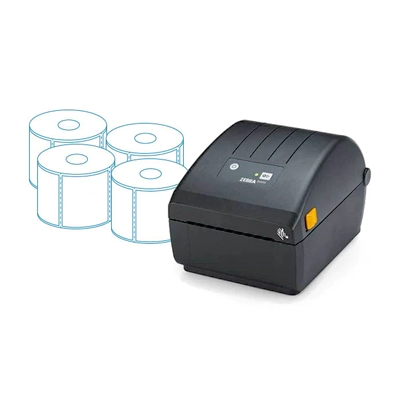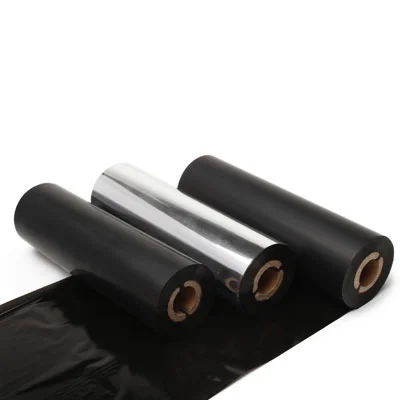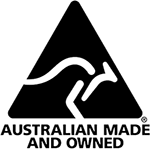FREQUENTLY ASKED QUESTIONS
Contact us if your query isn’t listed here
What does a die cut label mean?
“Die Cut” usually means that the label is cut out with a “cookie cutter” to create the shape that you want the label to be. Die cut may mean your label or tag will have rounded corners as opposed to square corners (which are often called “butt” or “kiss” cut). One advantage of a die cut label is that it is easier to remove from the backing paper and apply.
For more information call (03) 9764 2882.
How to select a ribbon type
Full Wax
The most common type of thermal transfer ribbon is the full wax ribbon. Wax thermal transfer ribbons are typically recommended for use on uncoated paper stock. While full wax ribbons provide a less durable print than their counterparts, they are also considerably less expensive.
A full wax thermal transfer ribbon is coated with a wax-based ink. During the printing process, heat from the printer’s print-head will melt the wax-based ink and transfer it to the surface of the thermal transfer labels, forming the desired printed area.
Full wax ribbons require a lower melting temperature than their counterparts, and are ideal for paper based materials. Applications that are well suited for full wax ribbons include: shipping labels, shelf and bin labels, retail labels, and warehouse labels.
Full Wax: Key points
- Most common type of thermal transfer ribbon
- Recommended for uncoated paper stock
- Less durable, but also less expensive
- Good for shipping, shelf, bin, retail and warehouse labels.
Wax-Resin
While not as cost effective as full wax ribbons, wax-resin ribbons are very popular because of the significantly more durable printed area they provide.
The printing process is actually very similar to the full wax printing process, where a hybrid of wax and resin based ink is melted and transferred on to the surface of the labels. The printed area will be a sharp, clear image that is much more resistant to heavy handling, chemicals, and temperature changes.
The melting temperature required for wax-resin ribbons falls between that of full wax ribbons and full resin ribbons. Wax-resin ribbons are ideal for a wide range of material types, from uncoated paper stock to coated, glossy paper stock and even synthetic weatherproof label materials. Wax-resin thermal ribbons have been tested extensively with our Thermal Transfer products and will provide a very high quality image. Applications well suited for wax-resin ribbons include: bar code labels, shipping labels, pharmaceutical and prescription labels, and shelf and bin labels.
Wax-Resin: Key points
- More durable printed area than full wax
- More resistant to heavy handling, chemicals and temperature changes
- Ideal for both standard and weatherproof thermal transfer labels
- Good for bar code, shipping, prescription pharmaceutical and shelf labels.
Full Resin
Full resin thermal ribbons will be considerably more expensive compared to full wax ribbons or wax-resin ribbons. This type of ribbon is generally intended for use on non-paper, synthetic stocks and will offer the highest durability of any ribbon type.
Full resin thermal ribbons will be considerably more expensive compared to full wax ribbons or wax-resin ribbons. This type of ribbon is generally intended for use on non-paper, synthetic stocks and will offer the highest durability of any ribbon type.
Full Resin: Key points
- Most expensive ribbon type
- For use on non-paper, synthetic stocks
- Most durable of the ribbon types.
What printer is best for me?
For easy small address type labels we would suggest the Dymo label writer 400. This is a compact direct thermal printer which usually prints 28mm x 89mm, 36mm x 89mm or 54mm x 101mm labels. These labels are suitable for envelopes, documents or shipping labels. They’re ideal for e-commerce and businesses which require smaller volumes.
For high volume usage, we recommend Zebra. This industry-standard printer brand offers a wide array of models for all types of end user needs.
Consider a mobile printer such as the RW420 for warehouse picking jobs. The printer can sit on a worker’s belt or mounted to a forklift or another vehicle. These printers use small rolls of direct thermal labels (100mm x 150mm on a 19mm core, usually with 100 on a roll).
The next size up is a desktop printer, typically used to print despatch labels for warehouses. Volume for these printers is usually less than 100 per day.
Models such as the GC and GK420 direct thermal printers take a roll of medium size labels, around 100mm wide with a 127mm maximum diameter on a 25mm or 38mm core. Also called shipping, despatch or transport labels, these labels are mostly 100mm x 150mm and are placed on the outside of a carton with a tracking barcode.
Industrial printers are the largest in our range, best for high-volume printing and heavy usage. The ZT range of printers are hard working and durable. These printers use larger diameter rolls, with 200mm or 150 metres of labels per roll, and come with a 76mm core to fit on a spindle or hang from a bar. They’re great for product identification and shipping. Industrial printers are a solid choice for businesses printing at least 100 labels per day.
What are labels made from?
Most self-adhesive labels are made from paper and consist of 3 layers manufactured by our raw material suppliers.
The top layer is called the facestock. This is the surface we print on, using label printing machines or clients’ printers. These printing papers can come in a variety of finishes, including white direct thermal paper, thermal transfer, high gloss, metallic, fluorescent or pastel options. The most common colourways are clear, white and silver.
The second layer of the construction is the adhesive. This is the glue on the back of the facestock that affixes the label to the intended surface. The most common adhesive types are permanent, removable and cold temperature grades for freezer and cool room applications.
The third part of the construction is the siliconized backing paper, or “carrier.” This allows the label to be handled and then to be peeled away easily to expose the adhesive for application. This allows the label to be effortlessly freed from the backing paper, as adhesives do not stick to silicon.
Label materials can be synthetic or manmade, with many different end uses. Some applications require extra-durable or liquid-resistant labels. Some labels are designed specifically for outdoor use or to withstand extreme weather conditions.
What sort of printing processes do you offer?
Dial A Label prints labels with many different processes.
For smaller volumes, we typically use flatbed UV letterpress or digital laser print.
Dial A Label prints larger volumes of work using the Rotary Flexographic process, either UV or hot air drying.
Flexographic machines print quickly and are best for plain direct thermal, thermal transfer or A4 laser printable sheets.
 0
0






